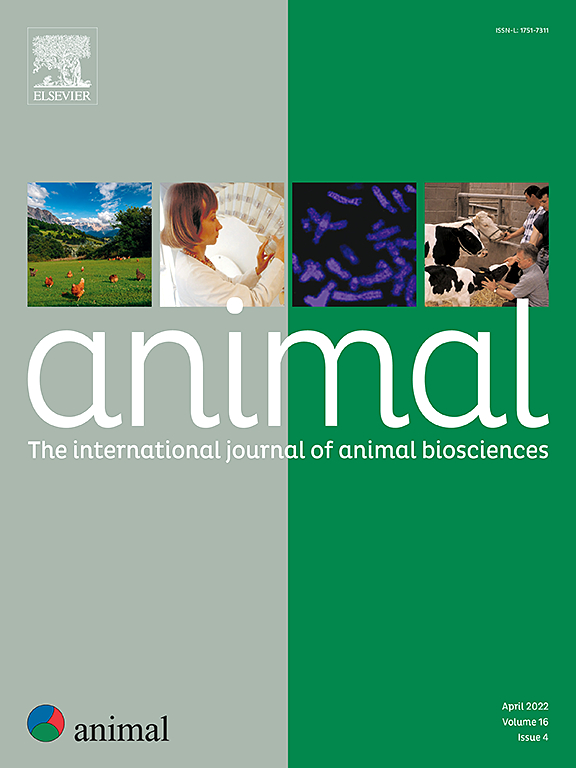Determination of urinary creatinine excretion and estimation of urinary nitrogen and purine derivatives in Wagyu, high-marbling fattening cattle
IF 4.2
2区 农林科学
Q1 AGRICULTURE, DAIRY & ANIMAL SCIENCE
引用次数: 0
Abstract
To improve the efficiency of nitrogen (N) utilisation in Wagyu (Japanese Black cattle), which are characterised by a distinct muscle-to-fat ratio, accurate estimation of urinary N and purine derivatives (PD) excretion is essential for researchers to evaluate and optimise feeding strategies. This study aimed to evaluate the use of creatinine-based spot urine sampling as a practical alternative to total urine collection for estimating urinary N and PD excretion in fattening Japanese Black cattle. Two experiments were conducted: a 4 × 4 Latin square design with four heifers and a 3 × 3 Latin square design with three heifers. These experiments evaluated the effects of various dietary treatments and sampling times on urine volume, creatinine, N, and PD concentrations. A total of 125 daily urine samples were collected from all seven heifers to determine creatinine excretion. Results showed that daily creatinine excretion in Japanese Black cattle averaged 24.7 mg/kg BW per day, lower than the 26.3 mg/kg BW per day calculated from literature data for other breeds (P < 0.001). This difference can be attributed to breed-specific variations in muscle mass and fat deposition related to feeding practices aimed at improving marbling. The highest estimation accuracy for N (R2 = 0.92, RMSE = 8.5 g/day) and PD (R2 = 0.38, RMSE = 16.9 mmol/day) was observed in spot urine samples collected between 0500 and 0900 h. These findings, based on comprehensive total urine collection from seven heifers, suggest that spot urine sampling using creatinine can reduce the labour and cost associated with total urine collection, making it a viable approach for monitoring N metabolism in large-scale fattening operations.
和牛高大理石纹育肥牛尿肌酐排泄量的测定及尿氮和嘌呤衍生物的测定
为了提高和牛(日本黑牛)的氮(N)利用效率,准确估计尿N和嘌呤衍生物(PD)的排泄对研究人员评估和优化饲养策略至关重要。本研究旨在评估以肌酐为基础的尿样取样作为总尿样采集的实用替代方法,用于估算育肥日本黑牛尿N和PD排泄。采用4 × 4拉丁方阵设计4头小母牛,3 × 3拉丁方阵设计3头小母牛。这些实验评估了不同饮食处理和采样时间对尿量、肌酐、N和PD浓度的影响。从所有7头小母牛身上每天收集125份尿液样本以测定肌酐排泄量。结果表明,日本黑牛日肌酐排泄量平均为24.7 mg/kg BW / d,低于其他品种的26.3 mg/kg BW / d (P <; 0.001)。这种差异可归因于不同品种的肌肉质量和脂肪沉积的差异,这些差异与旨在改善大理石纹的饲养方法有关。在0500 ~ 0900 h采集的尿样中,N (R2 = 0.92,RMSE = 8.5 g/day)和PD (R2 = 0.38,RMSE = 16.9 mmol/day)的估计精度最高。这些研究结果基于对7头小母牛的全面尿液采集,表明使用肌酐进行现场尿液采样可以减少与尿液采集相关的劳动力和成本,使其成为大规模育肥操作中监测N代谢的可行方法。
本文章由计算机程序翻译,如有差异,请以英文原文为准。
求助全文
约1分钟内获得全文
求助全文
来源期刊

Animal
农林科学-奶制品与动物科学
CiteScore
7.50
自引率
2.80%
发文量
246
审稿时长
3 months
期刊介绍:
Editorial board
animal attracts the best research in animal biology and animal systems from across the spectrum of the agricultural, biomedical, and environmental sciences. It is the central element in an exciting collaboration between the British Society of Animal Science (BSAS), Institut National de la Recherche Agronomique (INRA) and the European Federation of Animal Science (EAAP) and represents a merging of three scientific journals: Animal Science; Animal Research; Reproduction, Nutrition, Development. animal publishes original cutting-edge research, ''hot'' topics and horizon-scanning reviews on animal-related aspects of the life sciences at the molecular, cellular, organ, whole animal and production system levels. The main subject areas include: breeding and genetics; nutrition; physiology and functional biology of systems; behaviour, health and welfare; farming systems, environmental impact and climate change; product quality, human health and well-being. Animal models and papers dealing with the integration of research between these topics and their impact on the environment and people are particularly welcome.
 求助内容:
求助内容: 应助结果提醒方式:
应助结果提醒方式:


